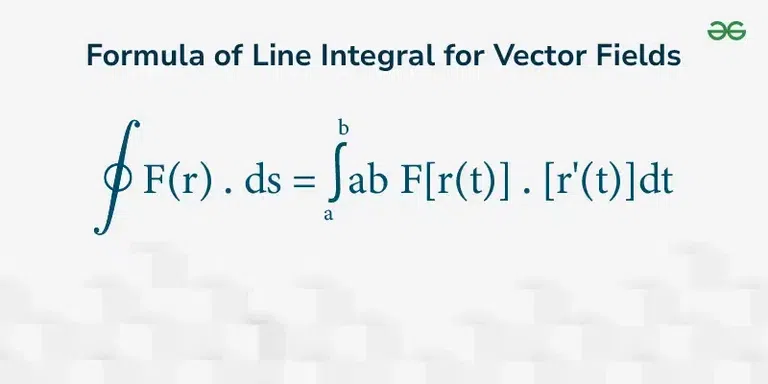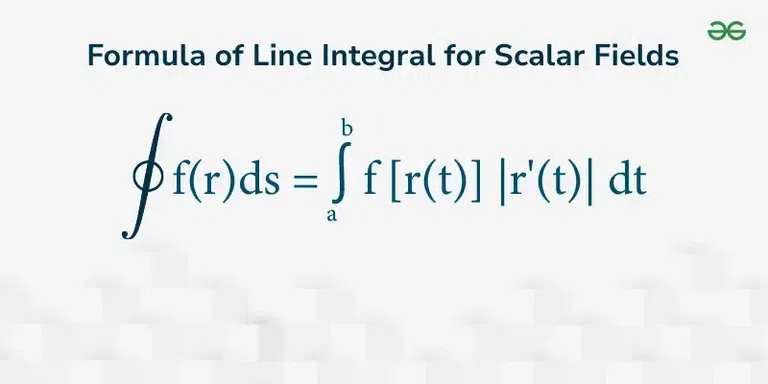
|
|
Line integrals are a mathematical construct used to estimate quantities such as work done by a force on a curved path or the flow field along a curve. In this article on line integrals, we will explore what line integrals are, their types, and how to compute them. We will also provide solved examples and practice questions to help you understand and master the concept of line integrals. Table of Content What are Line Integrals?Line integrals are used for the integration of a function along a curve in a plane or space. They help in finding such quantities as work done by fields of force, or flux of vector fields. Line integrals can be calculated with respect to arc length or with respect to the coordinate variables. It means parameterizing the curve and expressing the function in terms of the parameterization, then integrating over the range of the parameter. Types of Line Integrals1. Line Integral of Scalar FieldsA line integral of a scalar field involves integrating a scalar function along a curve. It is used to find quantities such as length, mass, and work. The general formula for a line integral of a scalar field is: [Tex]∫ C f(x,y)ds[/Tex] Here, (ds) represents an infinitesimal segment of the curve C, and f(x, y) is the scalar function being integrated. 2. Line Integral of Vector FieldsA line integral of a vector field involves integrating a vector field along a curve. It is commonly used in physics to calculate work done by a force field along a path. The general formula for a line integral of a vector field is: [Tex]∫ C F⋅dr[/Tex] Here, F is the vector field and dr represents an infinitesimal displacement vector along the curve C. How to Compute Line IntegralsParameterizing the CurveTo compute a line integral, the curve C must be parameterized. This involves expressing the coordinates x and y as functions of a parameter t: [Tex]x=x(t),y=y(t),a≤t≤b[/Tex] This parameterization converts the integral over the curve into an integral over the parameter t. Line Integral Formula of Scalar Fields Line Integral Formula of Vector Fields Line integrals provide a basic tool for understanding and quantifying the process of change along paths in space, making them of central importance in a subject like Electromagnetism and Fluid Dynamics. Line Integrals Practice Questions – SolvedThese solved Line Integrals Practice Questions will help you understand the application of the concept and how to use it to solve various problems. 1: Evaluate ∫C(x + y) ds, where C is the straight line from (0, 0) to (1, 1).
2: Evaluate ∫C F · dr, where F(x, y) = yi + xj and C is the unit circle centred at the origin, traversed counterclockwise.
3: Calculate the work done by the force field F(x, y) = (2x+y)i + (x-y)j along the path from (0, 0) to (2, 1) following the parabola y = x²/4.
4: Find the circulation of F(x,y) = yi – xj around the square with vertices at (0, 0), (1, 0), (1, 1), and (0, 1), traversed counterclockwise.
5: Calculate the flux of F(x, y) = xi + yj across the curve y = x², from x = 0 to x = 1.
6: Show that the line integral of F(x,y) = (2x+y)i + (x+2y)j is independent of path by evaluating it along two different paths from (0,0) to (1,1).
Line Integrals Practice Questions- UnsolvedSolve these Line Integrals Practice Questions to test your understanding on the concept of Line Integrals. 1. Evaluate ∫C (x + y) ds, where C is the line segment from (0,0) to (1,1). 2. Calculate ∫C (x2 + y2) ds, where C is the circle x2 + y2 = 4 traversed counterclockwise. 3. Find the work done by the force field F(x,y) = (y, -x) along the path from (1,0) to (0,1) along the parabola y = x2. 4. Compute ∫C (xy dx + x2 dy), where C is the curve y = x3 from (0,0) to (1,1). 5. Evaluate ∫C (ex cos y dx + ex sin y dy), where C is the straight line from (0,0) to (ln 2, π/4). 6. Calculate the line integral of f(x,y,z) = xyz along the helix r(t) = (cos t, sin t, t) for 0 ≤ t ≤ 2π. 7. Find ∫C (x dy – y dx), where C is the ellipse x2/4 + y2/9 = 1 traversed clockwise. 8. Evaluate ∫C (y dx – x dy) / (x2 + y2), where C is the upper half of the circle x2 + y2 = 1. 9. Compute the work done by F(x,y) = (2xy, x2) along the path from (0,1) to (2,3) following y = x + 1. 10. Calculate ∫C (z dx + x dy + y dz), where C is the intersection of the plane x + y + z = 1 and the cylinder x2 + y2 = 1.
Line Integrals Practice Questions – FAQsWhat is a Line Integral?
What are Two Main Types of Line Integrals?
What is Notation for a Line Integral?
What are Applications of Line Integrals?
What is Green’s Theorem and How does it relate to Line Integrals?
How do you Evaluate a Line Integral?
|
Reffered: https://www.geeksforgeeks.org
| Mathematics |
Type: | Geek |
Category: | Coding |
Sub Category: | Tutorial |
Uploaded by: | Admin |
Views: | 19 |